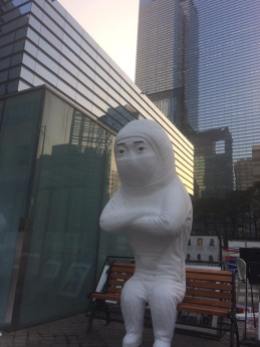
After five years of legal battle, a former Samsung employee, Kim Mi-seon won a ruling in favor of her workers compensation claims. Her handwritten sign reads: “Samsung must apologize, sufficiently compensate its victims and have [safety] measures in place.”
An appellate panel of Seoul’s administrative court has ruled a former Samsung Electronics Co., Ltd. worker’s multiple sclerosis was caused by a combination of overwork and chemical exposure at the company’s LCD unit: the first-of-its-kind reversal of several earlier decisions that denied Samsung cluster victims workers compensation.
3.5 in 100,000
In the ruling on Feb 10, the court said the Korea Workers Compensation and Welfare Service should pay medical expenses for Kim Mi-seon, a 37-year-old former Samsung woman worker suffering from multiple sclerosis.
The condition is so rare that only 3.5 in every 100,000 Koreans fall victim to it.
Kim was diagnosed with multiple sclerosis in 2000 when she turned 20—after about three years of cleaning and soldering LCD and OLED panels 12 hours a day at Samsung Electronics’ LCD line, now part of Samsung Display Co., Ltd. In 2013, she filed an administrative lawsuit against KCOMEL after the agency rejected her petition for workers compensation.
“[Over the period] she was exposed to acetone and organic solvents,” the ruling read. “Kim, then under 20 of age, worked frequent night shifts in an enclosed space, which factored in her condition by limiting UV exposure.”
Four Patients
The ruling established the work relatedness of Kim’s multiple sclerosis by citing the facts that there are four confirmed cases of multiple sclerosis among former Samsung employees and that there were no other factors than her working conditions that could cause Kim’s condition.
Kim is the first victim from Samsung’s LCD unit to have successfully claimed workers compensation. In 2012-2014, KCOMWEL or the court and turned down the claims filed by three Samsung LCD workers who contracted multiple sclerosis.
During the four years of legal procrastination, Kim’s health imploded substantially, to the point of near-complete vision loss and severe sciatica. She is now bed-ridden.
One Out of 13
It was Samsung, with the connivance of the government, that created a series of procedural delays. “Samsung and its suppliers repeatedly defied court requests to provide chemical data used in LCD production,” said Lim Ja-woon, the attorney with SHARPS who represented Kim.
Since May 2013, Samsun has complied with only one out of the 13 separate disclosure requests–four of them for one supplier over the same material–filed by Lim with the court.
KCOMWEL has appealed the ruling, SHARPS learned on Feb. 27. Twice in the past, in Nov. 2014 and Jan. 2016, the workers comp agency appealed two separate rulings in favor of two women victims assisted by the advocacy group.
Samsung Fuels Presidential Malfeasance
Over the past four months, SHARPS emerged as a strong contingent in the weekly candlelight protests that have been lighting up central Seoul by drawing a total of more than 10 million protesters. They have been calling for an immediate ouster of President Park Geun-hye and the arrest of Samsung’s heir apparent Lee Jae-yong for, among many other things, their collusion in an influence-peddling scheme.

SHARPS is an important contingent in ongoing mass protests against political corruption.
SHARPS’s Sit-in Continues
Since Oct. 7, 2015, SHARPS and its supporters have been staging a sit-in at Samsung D’light, the company’s so-called global exhibition space in south Seoul, calling for the world’s largest technology company to: 1) compensate all victims of occupational disease transparently and sufficiently; and 2) make a sincere and full apology.
On Feb. 4, SHARPS seated a new statue of Semiconductor Girl, the symbol of Samsung cluster victims, at their sit-in. Setting apart from the smaller and innocent-looking old one, the new statue bears an image of a girl in a white dirt-free suit with a piercing stare and folded arms.
Semiconductor Girl: Before and After
Update, Feb. 27, 2:30PM EST: Updated to include a decision by KCOMWEL to appeal the ruling.




Leave a comment